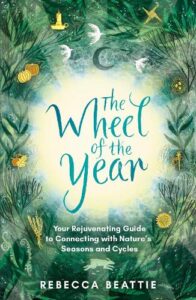The Wheel of the Year. Your nurturing guide to discovering nature’s seasons and cycles
Rebecca Beattie
Elliott & Thompson, 2022. ISBN 978-1-78396-679-0. £ 12,99
Although it is written by a (Gardnerian) Wiccan priestess, this is not a book about religion, but a book about connecting to nature and all that you can find there. It is about connecting to nature’s cycles through the important pause points in the year: the quarter days and cross quarter days of Druids and Wiccans. Two cycles combined in the 1950s and 1960s by Ross Nichols and Gerald Gardner to form the Wheel of the Year. “You’ll find out about the festivals themselves – the myths, traditions, the spiritual and practical elements – and I’m also going to encourage you to think about what is going on in the natural world, to engage with the changing of the seasons at those times by going on walks or jotting down your observations in a journal”.
The magic you will find in the book are some seasonal spells to help you communicate with your unconscious self. Practical activities – using different crafts – are encouraged, and short rituals are offered for each sabbat “to help give you a moment to pause, to connect to nature and reflect on your inner thoughts. This is really the point of the Wheel.”
Each sabbat is presented with its themes or qualities and correspondences, including the compass point that it is associated with, the planetary ruler and a tarot card. The book is divided into eight chapters on the eight sabbats, but you can start anywhere on the Wheel. I started with chapter 8, ‘November Eve or Samhain’, but the book starts “with Yule or midwinter, as this marks the ‘birth of the sun’, which seems as good a place as any to begin”. I am not happy with the association of birth with midwinter – since actual births are the theme of Imbolc or Oimelc, in the beginning of February – but the ‘spark’ can be put around Midwinter. But paging through this chapter, I can only see things I do agree with. For instance about the nonsense of new year’s resolutions, and that starting the year at Samhain only moves the pressure. “Instead, the Wheel gives us the opportunity to start afresh whenever we feel the need, to nurture ourselves whatever the time of year. To my mind, it really doesn’t matter when new year is – every day can mark a beginning.”
Samhain – the correct pronunciations are also given – is NOT the same as Hallowe’en. It is far older than that commercialised version of a Christian festival, and has to do with honouring our ancestors. And it has to do with facing our own mortality. Themes of death and resurrection are common in old myths and legends, such as those of Osiris and of Dementer and Persephone. It is the time of the ‘blood harvest’, when ‘the veils are thin’. We enter the dark part of the year.
“There is a stillness and an internal focus that has started to take root and that will see us through winter. Rather than feel frustration at how this interferes with the usually fast pace of life, try to let go of any expectations and breathe in the stillness. Stillness brings tranquillity, which brings insight. Insight brings understanding, and understanding brings wisdom, with a renewed sense of purpose.”
Connecting to our ancestors does not necessarily mean our biological ancestors, but also our ‘logical family’, people who have walked our path before us. For Rebecca Beattie nature loving writers are her logical ancestors, but it can also be ones spiritual ancestors: the ones from your tradition and line in Wicca. You might want to focus on your ancestors: the people you admired, that inspired you in any area of life that brings you joy, be it spiritual, your working life or other.
Other ways to celebrate Samhain are to find nature in quiet places – like visiting burial places – or several other ways, or to use the given ritual.
The book concludes with references for each chapter, and a list of titles for ‘Further reading’. All the books or authors I had hoped to find there are indeed included, and I will look into the titles I was not yet familiar with.

